5 December, 2001
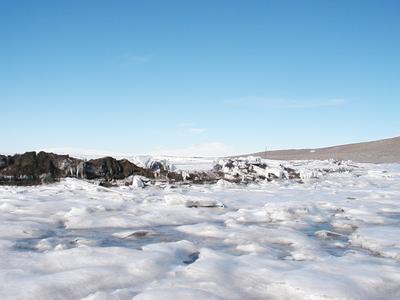
The "ice covering" breaks easily as we make our way across the moat and over the transition zone. My one hope is that the water will not go over my knees before I even begin the day. The waterproof bunny boots keep our feet warm and dry as long as the water doesn't go over the top of the boots.

The bunny boots are not enough to keep the water out, so we must wear waders, or in my case "special waders" made out of plastic bags and duck tape. So far this week, I have been fortunate to keep my feet dry during the day, but the cold water always gets in when I cross the moat later in the evening. I usually hang my boots up high so that the rising heat will dry them before morning. This will be one of our longest days, since the divers will be making two dives, and we will be closing down camp before we leave for McMurdo tomorrow.
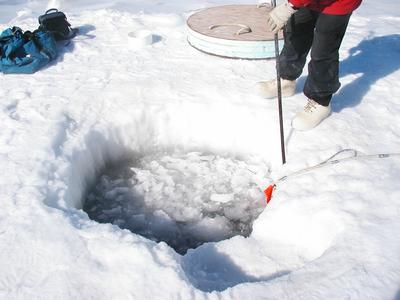
Dr. Bowser and Dr. Alexander will be making the first dive at the "Joan" dive site. All of the dive holes have names. This one is named for Dr. Joan Bernhard, one of the team members who will be joining this group in January. Dr. Bernhard's research has led her to dive under the Antarctic ice with this team on previous occasions. One of our first jobs as tenders is to remove the ice from the dive hole.

I am using a net to scoop the ice from the dive hole. I cleared the dive hole of ice before the dive, but also removed more ice after the divers went down. Dr. Korsun used a breaker bar to scrape ice from around the dive hole to widen it for the divers.
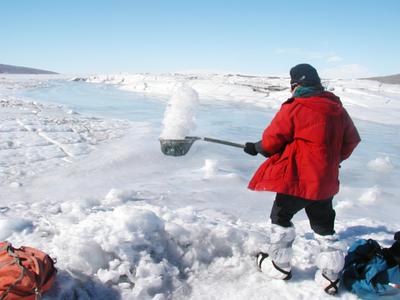
We throw the ice away from the dive hole as we scoop it out of the hole. We try to keep the area around the dive hole clear and groomed for safety purposes, especially as the divers enter and leave the water.

The divers also help groom the site, as well as unload and repack their gear. The basket will be lowered into the dive hole to hold sediment cores. "Spike" is checking out Dr. Bowser's fins. Dr. Alexander always takes his dive camera with him (See journal entries, November 27th and 29th)

Dr. Korsun is assisting Dr. Bowser with his dive gear, while Dr. Alexander makes a few last minute adjustments before going down below the ice. Today has been the most beautiful day of the whole season. The temperature has reached 30 degrees Fahrenheit, and there is little wind. It feels like a nice spring, sunny day!

Dr. Bowser has on full dive gear. Note that in Antarctica, the divers wear two dive tanks. They wear several layers under their dry suits. Only their mouths are exposed to the cold numbing water. They also carry a hand-held flashlight to view things under water.
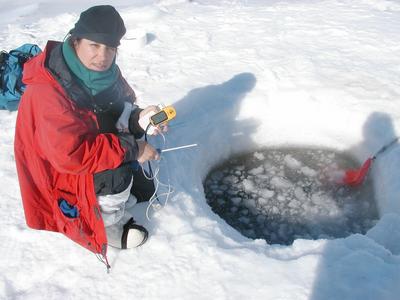
While the divers were below the surface, I finished scooping ice out of the dive hole. I then took the temperature of the water with the PASCO Scientific Xplorer Pasport (data logger with a temperature probe). I also used a GPS (Global Positioning System) to get the latitude and longitude of this dive hole. This little Garmin e-trex was extremely lightweight, as well as waterproof. I used the GPS to determine the location of each site where I collected data. Since today was a beautiful day, I only needed a wind jacket and a neck warmer. Note that I even took off my gloves to take the GPS reading. I only had to wear lightweight gloves today, which is much better than the two to four pairs that I normally wear at one time. My fingers always felt the cold first.

After the dive we replace the cover on the dive hole before going back to the dive hut.
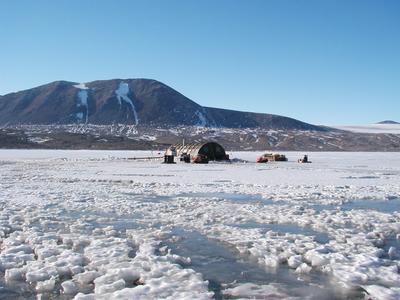
The dive hut sits out on the sea ice. I took this photo from the dive site before heading back across the sea ice to the hut. The ice is about 12-feet deep. The seawater beneath the ice is 28 degrees Fahrenheit. There are several dive holes in this area, and each site is a little different from the other. The depth may vary, or the dive may be different due to the location (delta area, near ice cliffs). The depth at the dive hut is about 80-feet deep. The divers can dive up to 120-130 feet in these Antarctic waters. The shallow water dives make Explorers Cove one of the few places on Earth where scuba divers have access to a region that resembles the deep ocean floor. The divers are collecting foram specimens from the bottom of these Antarctic waters to study changes over time. During this field season, the research will extend through February in order to document Austral spring to late-summer changes.
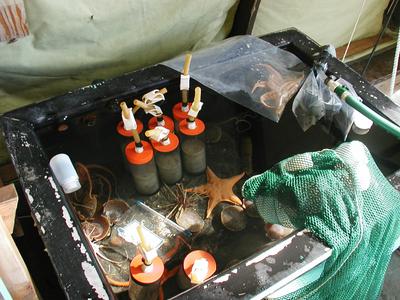
Since we will be going back to McMurdo tomorrow, we will be taking specimens back to the Crary Lab. The specimens are kept in the dive hut's field camp aquarium in cold seawater. It takes several hours to prepare specimens to be transported to McMurdo, especially when everything has to be carried across the moat. I think everyone finally got to bed about 5 a.m.
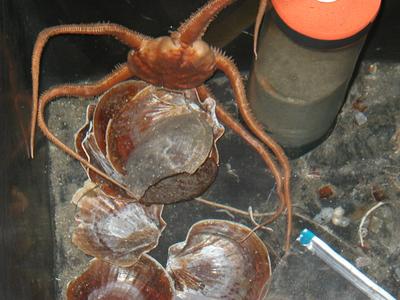
The foram-laden sediment cores are stored in the aquarium along with starfish, brittle stars, and scallops. The scallops have forams on their thin shells. Norbert Wu, a legendary photography of underwater life in Antarctica, will be having a documentary coming out soon on PBS. This video will also show life under the ice at New Harbor. Although, I couldn't dive here, this video will allow me to see these organisms in their underwater environment.

I was surprised to see how colorful the starfish are in Antarctica. I expected small dull creatures; instead I saw some large beautiful marine organisms.
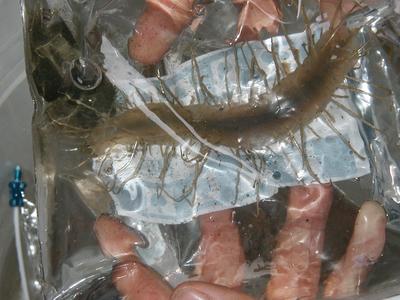
This spiky creature is a polychaete worm called Flabelligera mundata. It can grow up to 10 cm long and 3 cm wide. It is a great example of how large the marine fauna may grow in these icy Antarctic waters. These creatures may also be found in the Falkland Islands and New Zealand.
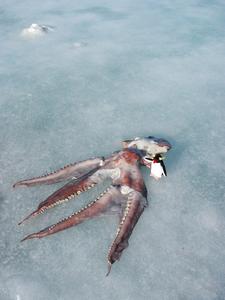
Spike is checking out a large octopus pulled from the water near the dive hut. The divers were a little wary after seeing that the head had a huge bite taken out of it, and whatever sampled the octopus was still in the waterJ (Aaagh!) Seriously, safety and life under the ice is a concern, but sharing a sense of humor makes a long day into a good one. I have learned a great deal each day as the divers discussed what they saw, where they saw it, and how it related to their research. I was constantly learning as each member of my team added to my learning by answering many questions and by "taking me under wing" to include me in this wonderful research project.
Contact the TEA in the field at
.
If you cannot connect through your browser, copy the
TEA's e-mail address in the "To:" line of
your favorite e-mail package.
|
